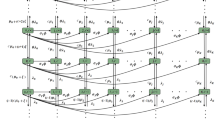Abstract
We consider the single server Markovian queue and we assume that arriving customers decide whether to enter the system or balk based on a natural reward-cost structure, which incorporates their desire for service as well as their unwillingness to wait.
We suppose that the waiting space of the system is partitioned in compartments of fixed capacity for a customers. Before making his decision, a customer may or may not know the compartment in which he will enter and/or the position within the compartment in which he will enter. Thus, denoting by n the number of customers found by an arriving customer, he may or may not know ⌊ n/a ⌋+1 and/or (n mod a)+1.
We examine customers’ behavior under the various levels of information regarding the system state and we identify equilibrium threshold strategies. We also study the corresponding social and profit maximization problems.
Similar content being viewed by others
References
Afeche, P., Mendelson, H.: Pricing and priority auctions in queueing systems with a generalized delay cost structure. Manag. Sci. 50, 869–882 (2004)
Aksin, O.Z., Armony, M., Mehrotra, V.: The modern call-center: a multi-disciplinary perspective on operations management research. Prod. Oper. Manag. 16, 665–688 (2007)
Altman, E., Jimenez, T., Nunez-Queija, R., Yechiali, U.: Optimal routing among ⋅/M/1 queues with partial information. Stoch. Models 20, 149–171 (2004)
Armony, M., Maglaras, C.: On customer contact centers with a call-back option: customer decisions, routing rules and system design. Oper. Res. 52, 271–292 (2004a)
Armony, M., Maglaras, C.: Contact center with a call-back option and real-time delay information. Oper. Res. 52, 527–545 (2004b)
Burnetas, A., Economou, A.: Equilibrium customer strategies in a single server Markovian queue with setup times. Queueing Syst. 56, 213–228 (2007)
Chen, H., Frank, M.: State dependent pricing with a queue. IIE Trans. 33, 847–860 (2001)
Chen, H., Frank, M.: Monopoly pricing when customers queue. IIE Trans. 36, 569–581 (2004)
Dewan, S., Mendelson, H.: User delay costs and internal pricing for a service facility. Manag. Sci. 36(12), 1502–1517 (1990)
Edelson, N.M., Hildebrand, K.: Congestion tolls for Poisson queueing processes. Econometrica 43, 81–92 (1975)
Guo, P., Zipkin, P.: Analysis and comparison of queues with different levels of delay information. Manag. Sci. 53, 962–970 (2007)
Ha, A.Y.: Optimal pricing that coordinates queues with customer-chosen service requirements. Manag. Sci. 47(7), 915–930 (2001)
Hassin, R.: Consumer information in markets with random products quality: the case of queues and balking. Econometrica 54, 1185–1195 (1986)
Hassin, R.: On the advantage of being the first server. Manag. Sci. 42, 618–623 (1996)
Hassin, R.: Information and uncertainty in a queuing system. Probab. Eng. Inf. Sci. 21, 361–380 (2007)
Hassin, R., Haviv, M.: Equilibrium strategies and the value of information in a two line queueing system with threshold jockeying. Commun. Stat.—Stoch. Models 10, 415–436 (1994)
Hassin, R., Haviv, M.: Equilibrium threshold strategies: the case of queues with priorities. Oper. Res. 45, 966–973 (1997)
Hassin, R., Haviv, M.: To Queue or Not to Queue: Equilibrium Behavior in Queueing Systems. Kluwer Academic, Boston (2003)
Hayel, Y., Ouarraou, M., Tuffin, B.: Optimal measurement-based pricing for an M/M/1 queue. Netw. Spat. Econ. 7, 177–195 (2007)
Jouini, O., Dallery, Y., Aksin, O.Z.: Queueing models for full-flexible multi-class call centers with real-time anticipated delays. Int. J. Prod. Econ. (2008, forthcoming)
Knudsen, N.C.: Individual and social optimization in a multi-server queue with a general cost-benefit structure. Econometrica 40, 515–528 (1972)
Larsen, C.: Investigating sensitivity and the impact of information on pricing decisions in an M/M/1/∞ queueing model. Int. J. Prod. Econ. 56–57, 365–377 (1998)
Mendelson, H., Whang, S.: Optimal incentive-compatible priority pricing for the M/M/1 queue. Oper. Res. 38(5), 870–883 (1990)
Naor, P.: The regulation of queue size by levying tolls. Econometrica 37, 15–24 (1969)
Ross, S.M.: Stochastic Processes, 2nd edn. Wiley, New York (1996)
Yechiali, U.: On optimal balking rules and toll charges in the GI/M/1 queue. Oper. Res. 19, 349–370 (1971)
Author information
Authors and Affiliations
Corresponding author
Rights and permissions
About this article
Cite this article
Economou, A., Kanta, S. Optimal balking strategies and pricing for the single server Markovian queue with compartmented waiting space. Queueing Syst 59, 237–269 (2008). https://doi.org/10.1007/s11134-008-9083-8
Received:
Revised:
Accepted:
Published:
Issue Date:
DOI: https://doi.org/10.1007/s11134-008-9083-8
Keywords
- Queueing
- Balking
- Equilibrium strategies
- Social optimization
- Profit maximization
- Nash equilibrium
- Pricing
- Compartmented waiting space
- Partial information




